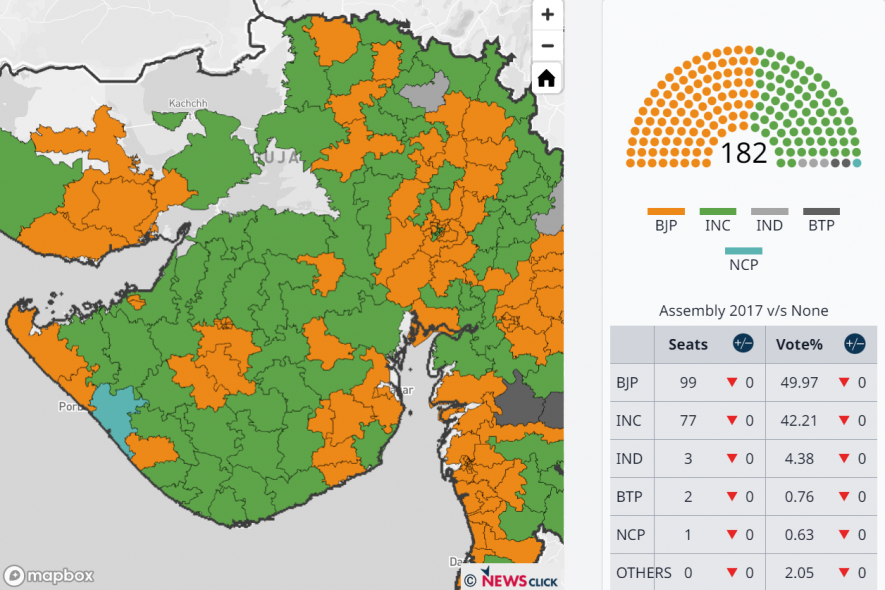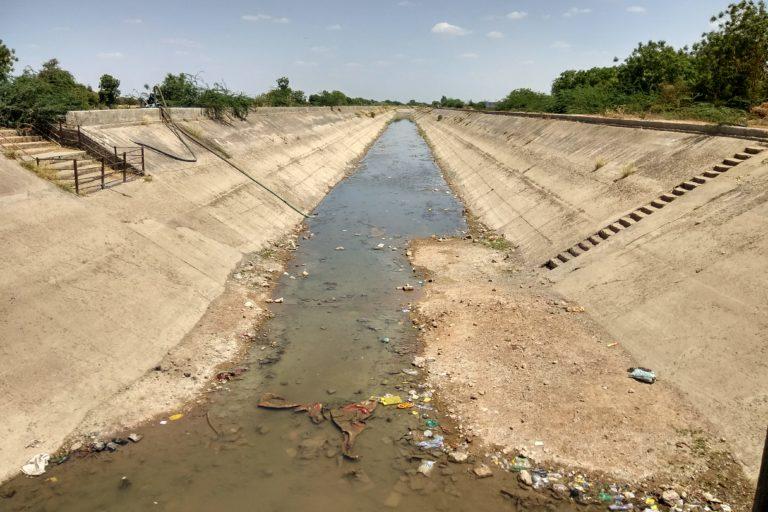Gujarat Polls: Hit by Water Crisis, High Inflation, and Low Income, Will Saurashtra Farmers Oust BJP?
Surendranagar, Rajkot, Bhavnagar, Amreli (Gujarat): The cotton farms of the Saurashtra region make for an iconic picture of barren and scorched land. The hot shining sun has replaced the pleasant weather, which generally prevails here in the month of November. Most of the farmers have harvested their cotton produce. The leftover cotton bolls on sporadic patches of land are yet to be stripped. A big question troubling the farmers in this election season is whether they will be able to grow the cash crop next year or not.
The severe shortage of water is one of the most crucial issues as cotton and peanuts crops are the major lifelines for hundreds and thousands of people from the drought-prone coastal region of the Arabian Sea. On an afternoon, days before the state heads for the two-phased Assembly polls beginning on December 1, many of the farmers sat near a tea shop at Sayla in the Limbdi constituency of Surendranagar district and talked about the “pointlessness” of voting.
Saurashtra is an important agricultural region of Gujarat and it includes several districts such as Surendranagar, Rajkot, Porbandar, Jamnagar, Junagadh, Amreli and Bhavnagar. Nearly two-thirds of the state’s population is engaged in agricultural activities.
“We are assured of unhindered water supply for irrigation throughout the year, but it has been turning out to be an electoral gimmick for the past 27 years,” said quinquagenarian Kanjiya Varsinhbhai Thakore, a resident of Kesarpar village, adding that people from several talukas (district subdivisions) of the district do not have even drinking water; forget about water for irrigation.

These talukas — he listed out — include Sayla, Chuda, Chotila, Thangadh and Muli. Water for domestic use and cattle is supplied by the state government through taps. When the tap water runs dry, the residents must trudge kilometres to fetch it.
Spread over 31% of the state’s landmass, Saurashtra gets only 9% of the water resources. It is even worse for Kutch at 2% for a geographical spread of 31%.
Where does the 4,000 million cubic feet of Narmada water diverted to dams and reservoirs in the water-scarce Saurashtra go?
Navinbhai Thakore, who belongs to Sayla’s Shapar village, offered a reply to the query.
“Only the villages (such as Wadhwan, Limbdi, Dhrangadhra, etc.) close to Nimbhani, Saburi, Falku and Vadod dams in Surendranagar get water for agricultural purposes, although the supply is insufficient. These dams release water into the canals, lakes, and ponds in the district only when it rains and the reservoirs start to overflow,” he said while speaking to NewsClick.
Most of the villages, he said, are located above the canals and require lift irrigation — which is expensive and further increases the already inflated production cost.
“Therefore, farmers are left with no option but to depend on rainfall for agricultural activities,” he added.
Over the years, the farmers in the region have heard of many schemes from linking ponds in the water-starved villages to nearby canals and small rivers to getting water under the Saurashtra Narmada Avtaran Irrigation (SAUNI) scheme over the years. But they have not benefited from any of them.
The scheme is aimed at diverting surplus water of Narmada to 115 reservoirs of 11 districts of Saurashtra through 1,126 km-long four-link pipelines, benefiting a total of 10,22,589 acres of land. But farmers in Saurashtra said that the scheme so far has proved to be a failure. The question, therefore, still remains unanswered. Where does the water from Narmada go?

“The surplus water is diverted from South Gujarat to Saurashtra for domestic use and irrigation. But it is sent to industries in Kutch, Amreli and some other coastal districts of the region. Diversion of Narmada water to 115 reservoirs of 11 districts of Saurashtra region has not made any impact here,” Katosna Ghughabhai Jagmahbhai, a resident of Sayla’s Jasapar village, angrily alleged.
The lack of water for irrigation in Saurashtra is a major cause of the acute agrarian crisis. Farmers are unable to grow more than one crop in a year. And that too depends on the rainfall. Cotton or peanuts — both Kharif crops — are planted in May-June before the commencement of the monsoon and harvested in September or October. Those who do late sowing reap the crop by November.
If it rains heavily, it fills the dam and recharges groundwater. As a result, wheat, bajra (millet), gram, cumin, soybean (edible beans) and castor are also grown. With an aim to maintain the fertility of the soil, farmers keep rotating their crops between cotton and groundnut.
“Even if there is 100 mm rainfall, it benefits us as ponds, lakes, and rivers get lined with the dams,” said the peasants.
When the rainfall is less, the crop gets destroyed or yields drop, which results in the piling of debt. The consistent shortage of water has reduced farmers to wage earners and caused the over-extraction of groundwater.
As 89 constituencies of the 182-member Gujarat Assembly go to polls in December, politicians associated with the ruling Bharatiya Janata Party (BJP), the Congress and the debutant Aam Aadmi Party (AAP) are going to districts, talukas and villages, spending crores of rupees on their rallies, and making tall claims. But the farmers are waiting for solutions to their woes – but to no avail.
“No one responds to our problems. Vada Pradhan (Prime Minister Narendra Modi) while addressing a public meeting (at Dhoraji town in Rajkot on November 21) slammed the Congress for stalling the Sardar Sarovar dam project for 30 years. He conveniently did not speak about why a large part of Saurashtra does not get water when the dam has been made functional. The BJP is ruling the state for the past 27 years, and he has been in the Centre for the last eight years,” said Jawerbhai, a farmer from Vanta Vachh village in Surendranagar.
Also read: Gujarat Elections: Rising Fodder Prices in Banskantha’s Dairy Hub Milking Small Farmers Dry
Referring to ‘Save Narmada Movement’ activist Medha Patkar – who joined Rahul Gandhi in the ‘Bharat Jodo Yatra’ in Maharashtra a few days back – Modi had said, “You must have seen in newspapers the photo of a Congress leader with a woman who had stalled the Narmada dam project for three decades. The leader had his hands on the woman’s shoulder while on the padyatra (foot march). Therefore, ask the Congress leader why he was walking with the anti-Narmada activist.”
The prime minister, instead of talking about people’s concerns, seems to be attacking Congress. He crisscrossed the state from Saurashtra to Bharuch, describing the Opposition as a party of “princely family” and contrasted himself as hailing from an “ordinary family”.
Bhavnagar’s Haribhai Bharwad alleged, “Grand claims made by the leaders never translate into results.”
“We have not got enough water for irrigation for the past three years even when it was available for the industries. After two-three months of the monsoon, we do get water for irrigation. And therefore, we have to leave our fields empty after growing cotton and groundnuts,” he said.
Even when the yield is high, he said, farmers do not get profitable rates from the market.
Veljibhai Patel, 65, a resident of Lathi village in Amreli district, says that the price of cotton is varying between Rs 8,850 – Rs 9,500 per quintal in the Agricultural Produce Market Committees (APMCs).
“It has improved this year because the production is low when compared to the previous marketing year of 2021-22. The government has increased the Minimum Support Price of Kharif crops for the marketing year 2022-23. Last year, it was between Rs 1,000-1,100,” he said.
Those who have big landholdings and have storage facilities at home get slightly better prices as they can afford to wait to sell at the end of the procurement.
“But small farmers cannot afford it. They need money soon after they harvest the crops. They need to clear their debt to take fresh credit for the next season and for other expenses. In addition, they do not have enough space to store it. Once they take the cotton to the mandi in tractor trolleys, they have no other option but to sell it at the best prices offered to them by the traders because transportation also incurs a good amount of expenditure,” he explained.
Surprisingly, Cotton MSP has increased to Rs. 6080 per quintal for medium staple and Rs. 6380 per quintal for long staple cotton.
Maheshbhai, a trader at APMC in Surendranagar’s Chotila, says one can get 10-20% profit by selling his cotton at this price if he does not need a workforce from outside his family.
According to him, the edible bean is being procured at a price varying between Rs 5,250-5,500 per 100 kg against the government rate of Rs 4,405 for the same quantity. “It’s a bit profitable because it incurs lesser production cost,” he said.
While the rate of the gram is between Rs 4,250-Rs 4,500 per quintal, groundnut is being procured at Rs 5,500 – 6,500, said Maheshbhai.
“The farmers are merely getting something with which they can somehow make the ends meet. To put it simply, they can recover their expenditures only. The profit margin is so thin that they cannot do anything extra with the amount they are getting,” said another trader, Jairajbhai Chotila.
PERMANENT DEBT TRAP
A famous saying in the Saurashtra region goes: “A farmer is always indebted. He is born in debt and dies in debt. What matters is how he manages this debt in his life.”
They borrow from banks to repay private lenders and reverse the cycle. Cooperative banks in Gujarat charge 7% interest on farmers’ loans for one year. The state and central governments give an interest subvention of 2% and 8% respectively.
Higher returns from the yield help peasants repay the debt on time. Lower return pushes them to borrow from private money lenders to return the borrowed sum to the banks. The private lenders charge them an interest of 8% per month on the borrowed amount.
To keep their credit score clean, they try to repay the banks within the stipulated time so that they can get another loan for the next season without any obstruction. Ten days after the first payment, they once again borrow to pay back the lenders. And this cycle continues.
According to data presented by the government in Parliament in August this year, the loan burden on peasants has dramatically risen from Rs 73,228.67 crore in 2019-20 to Rs 96,963.07 crore in 2021-22 – courtesy of rising input costs (be it the rate of seeds, fertilisers, pesticides, diesel).
The data tabled by the Union Ministry of Agriculture also suggests that the ticket size of borrowings for agriculture has also hiked by 45% over the past two years. The agriculture credit per account has grown to Rs 2.48 lakh from Rs 1.71 lakh during the quarter.
POWER EQUATION
The first phase of the state election is more crucial for the BJP, as it will be held across the Congress strongholds of Saurashtra and south Gujarat. The second phase is scheduled to be held on December 5.
If the BJP has to retain power in the state, it will have to grab 89 seats in the South Gujarat and Saurashtra regions, which are dominated by tribals, Patidars and other farming communities.
There seems to be a tough battle in the 48 constituencies of the Saurashtra region, where the Congress won 28 seats in the 2017 election, riding a wave of discontent among farmers and traders and the agitation for quotas by Patidars.
The AAP is hoping that its promise of better governance delivery will help it win support, especially in the semi-urban and rural seats. If the Arvind Kejriwal-led party performs well in rural areas, it is likely to hugely impact the prospects of the Congress. And if it eats into the urban vote base, the BJP would bear the brunt.
Results of the Gujarat polls will be announced on December 8, along with the results for Himachal Pradesh.
Also read: Gujarat Elections: Temple With 2 Doors Leads to Different Realities
Get the latest reports & analysis with people's perspective on Protests, movements & deep analytical videos, discussions of the current affairs in your Telegram app. Subscribe to NewsClick's Telegram channel & get Real-Time updates on stories, as they get published on our website.














